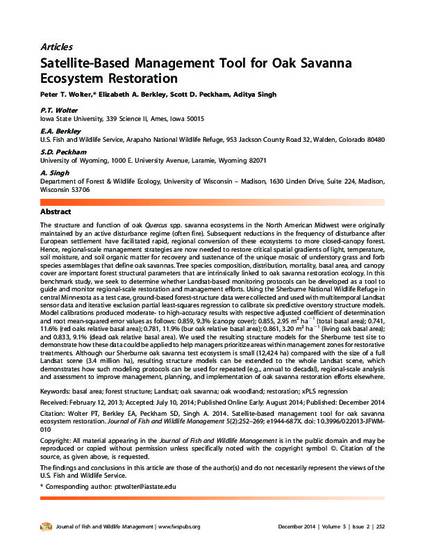
The structure and function of oak Quercus spp. savanna ecosystems in the North American Midwest were originally maintained by an active disturbance regime (often fire). Subsequent reductions in the frequency of disturbance after European settlement have facilitated rapid, regional conversion of these ecosystems to more closed-canopy forest. Hence, regional-scale management strategies are now needed to restore critical spatial gradients of light, temperature, soil moisture, and soil organic matter for recovery and sustenance of the unique mosaic of understory grass and forb species assemblages that define oak savannas. Tree species composition, distribution, mortality, basal area, and canopy cover are important forest structural parameters that are intrinsically linked to oak savanna restoration ecology. In this benchmark study, we seek to determine whether Landsat-based monitoring protocols can be developed as a tool to guide and monitor regional-scale restoration and management efforts. Using the Sherburne National Wildlife Refuge in central Minnesota as a test case, ground-based forest-structure data were collected and used with multitemporal Landsat sensor data and iterative exclusion partial least-squares regression to calibrate six predictive overstory structure models. Model calibrations produced moderate- to high-accuracy results with respective adjusted coefficient of determination and root mean-squared error values as follows: 0.859, 9.3% (canopy cover); 0.855, 2.95 m2 ha−1 (total basal area); 0.741, 11.6% (red oaks relative basal area); 0.781, 11.9% (bur oak relative basal area); 0.861, 3.20 m2 ha−1 (living oak basal area); and 0.833, 9.1% (dead oak relative basal area). We used the resulting structure models for the Sherburne test site to demonstrate how these data could be applied to help managers prioritize areas within management zones for restorative treatments. Although our Sherburne oak savanna test ecosystem is small (12,424 ha) compared with the size of a full Landsat scene (3.4 million ha), resulting structure models can be extended to the whole Landsat scene, which demonstrates how such modeling protocols can be used for repeated (e.g., annual to decadal), regional-scale analysis and assessment to improve management, planning, and implementation of oak savanna restoration efforts elsewhere.
Available at: http://works.bepress.com/peter-wolter/10/

This article is from Journal of Fish and Wildlife Management 5 (2014): 252, doi: 10.3996/022013-JFWM-010.